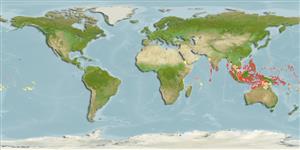Teleostei (teleosts) >
Gobiiformes (Gobies) >
Gobiidae (Gobies) > Gobiinae
Etymology: Asterropteryx: Greek, a = with + Greek, sterros, -a, -on = consistent + Greek, pteryx = fin (Ref. 45335); bipunctata: Named for its characteristic markings, ocellated black spot at the base of first 3 dorsal spines and a similar spot with orange margin at the base of middle caudal-fin rays.
Environment: milieu / climate zone / depth range / distribution range
Ecology
Marine; reef-associated; depth range 12 - 38 m (Ref. 31115). Tropical
Indo-Pacific: Indo-Melanesian Archipelago from Sabah to Solomon Is.
Size / Weight / Age
Maturity: Lm ? range ? - ? cm
Max length : 3.1 cm SL male/unsexed; (Ref. 31115)
Dorsal spines (total): 7; Dorsal soft rays (total): 10; Anal spines: 1; Anal soft rays: 8 - 10. Body whitish with orange spots covering both body and head; a black spot at the base of dorsal-fin spines and another at base of caudal. Preopercle spines, 4-7. Well-developed basal membrane of pelvic fin, extending for most of length of innermost ray. Caudal fin rounded to lanceolate. Cycloid scales on head, cheek and opercle, also on pectoral base and prepelvic region; ctenoid scales on predorsal and the rest of the body (Ref. 31115).
Found in sand and rubble patches, located on ledges of steep seaward or lagoon reef slopes or at the base of these slopes. The fish lies on the bottom, retreating into crevices when threatened (Ref. 31115). Solitary (Ref 90102).
Life cycle and mating behavior
Maturity | Reproduction | Spawning | Eggs | Fecundity | Larvae
Allen, G.R. and P. Munday, 1995. Description of four new Gobies (Gobiidae) from the Western Pacific Ocean. Rev. Fr. Aquariol. 22(3-4):99-104. (Ref. 31115)
IUCN Red List Status (Ref. 130435: Version 2024-2)
Threat to humans
Harmless
Human uses
Tools
Special reports
Download XML
Internet sources
Estimates based on models
Preferred temperature (Ref.
123201): 27.2 - 29, mean 28.2 °C (based on 136 cells).
Phylogenetic diversity index (Ref.
82804): PD
50 = 0.5039 [Uniqueness, from 0.5 = low to 2.0 = high].
Bayesian length-weight: a=0.00724 (0.00339 - 0.01546), b=3.10 (2.92 - 3.28), in cm total length, based on LWR estimates for this (Sub)family-body shape (Ref.
93245).
Trophic level (Ref.
69278): 3.4 ±0.5 se; based on size and trophs of closest relatives
Resilience (Ref.
120179): High, minimum population doubling time less than 15 months (Preliminary K or Fecundity.).
Fishing Vulnerability (Ref.
59153): Low vulnerability (10 of 100).
